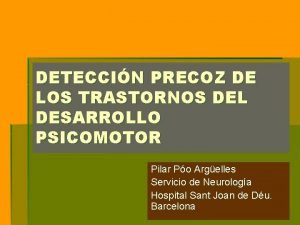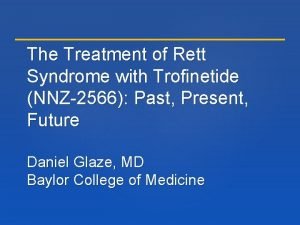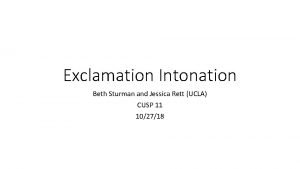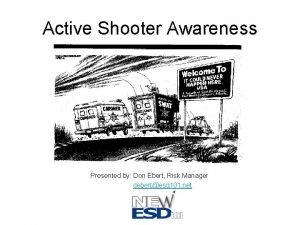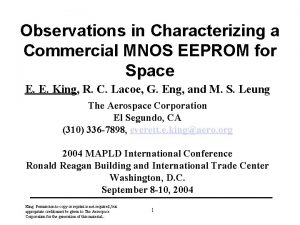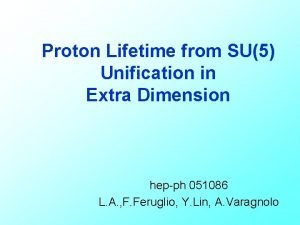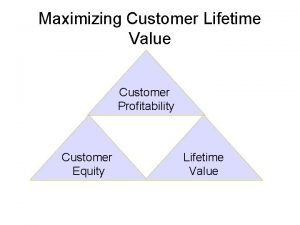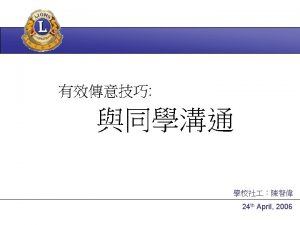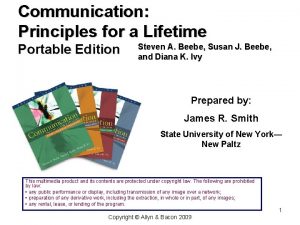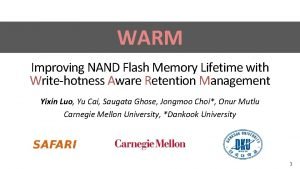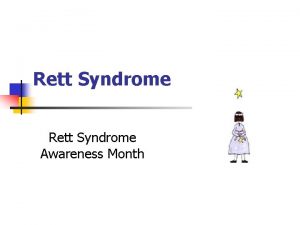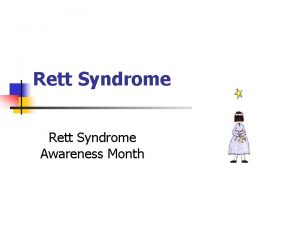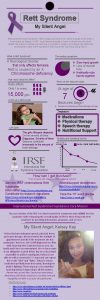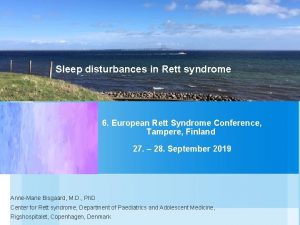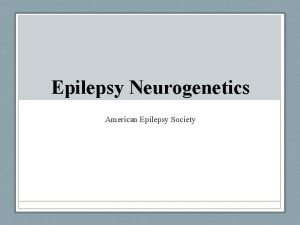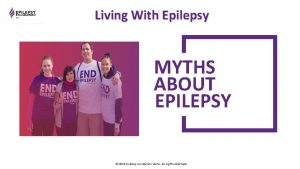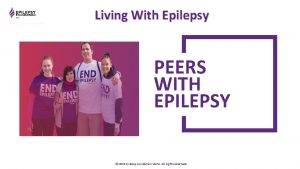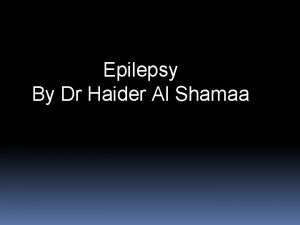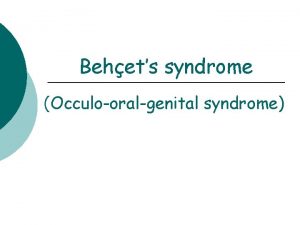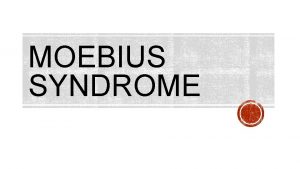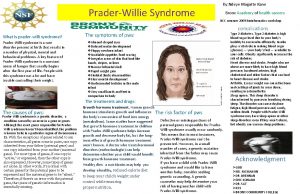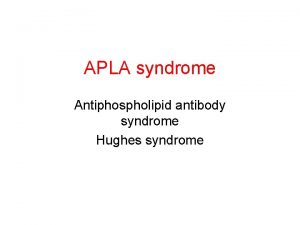Epilepsy in Rett syndrome from a lifetime perspective































- Slides: 31

Epilepsy in Rett syndrome – from a lifetime perspective Mari Wold Henriksen MD/Phd-student Drammen hospital VVHF/University of Oslo Norway

Prevalence 70 -90% Multiple seizure types Epileptic versus non-epileptic seizures Epilepsy in Rett Syndrome Pattern of remission and relapse

• The Rett syndrome Natural History Study • Prospective cohort • Up to 8 years follow up • 1205 participants Pattern of remission and relapse • Aged 8 months-66 years

Ever No seizures Epilepsy in Rett syndrome Remission/relapse Never experienced remission During study

• Average duration 1 year • 7% ≥ five years • 41% of study population Remission/relapse No seizures Remissions and relapses 0, 5 yr 1 yr Never remissions 5 yrs Tarquinio et al. , 2017

Prevalence 70 -90% Multiple seizure types Epileptic versus non-epileptic seizures Epilepsy in Rett Syndrome Pattern of remission and relapse Drug resistant in ∿ 30% Affects quality of life

Epilepsy is rare Early seizure variant Epilepsy in children <2 years of age Not MECP 2 Charman et al. , 2005. Nissenkorn et al. , 2010 Earlier onset correlates with more severe epilepsy Nissenkorn et al. , 2015. Pintaudi et al. , 2010 Early childhood (0 -2 years)

Onset between 2 -5 years of age No characteristic first seizure 2 5 Medication Childhood

Childhood

Onset between 2 -5 years of age No characteristic first seizure Valproate acid first choice(? ) Medication Vignoli et al. , 2017 Approach: Childhood

Approach: Childhood

Approach: Seizures First drug Effect Some effect Add second drug Effect No effect Change to second drug No effect Effect No effect Are you really sure it is epileptic? Krajnc, 2015

Onset after age 10 are rare Puberty(? ) High seizure burden Medication Adolescence Multiple drugs often required Carbamazepin most efficient(? ) Vignoli et al. , 2017

Less epilepsy? ? “After the teenage period seizures generally declined with age” Witt-Engerstrøm, 1992 “On the whole, epilepsy tended to quieten down after 20 years of age” Steffenburg, 2001 “We observed no significant differences in drug responsiveness between patients with epilepsy ≥ 20 years of age and younger subjects” Pintaudi, 2010 Adulthood “(…) These findings indicate that management of epilepsy remains a serious challenge in ageing women” Anderson, 2014

Excluded N=2 N≈160 93 ü Interview ü Clinical examination ü Genetic investigation ü Review of medical journals Classic RTT N=74 Atypical RTT N=10 RTT-like N=7

Excluded N=2 N≈160 93 ü Interview ü Clinical examination ü Genetic investigation ü Review of medical journals Missing data n=2 Classic RTT N=74 Atypical RTT N=10 RTT-like N=7 Epilepsy study N=72

Age 1 -10 years 11 -20 years 21 -30 years >30 years Epilepsy study N=72

Prevalence of active epilepsy 100% 90% 2 80% 4 70% 2 3 4 4 60% 50% 40% Never seizures Seizure free last five years 7 30% Active epilepsy 20% 10% 0% 5 12 10 14 1 -10 år n=12 11 -20 år n=18 21 -30 år n=16 >30 år n=21 Henriksen, 2018

Prevalence of active epilepsy 100% 90% 80% 70% Never seizures 60% 50% Seizure free last five years 40% 30% Active epilepsy 20% 10% 0% 1 -10 years n=17 12 10 14 11 -20 years n=18 21 -30 years n=16 > 30 years n=21 Henriksen, 2018

Frequency of seizures 100% 90% 2 80% 3 70% < monthly 60% 50% 6 2 5 < weekly, ≥ monthly 40% 2 ≥ weekly 30% 20% 10% 0% 4 5 7 11 -20 years n=12 21 -30 years n=10 >30 years n=14 Henriksen, 2018

Seizure types 100% 90% 80% 3 70% 5 60% 5 50% Other seizures 40% Bilateral tonicclonic seizures 30% 20% 10% 7 0% 11 -20 år 9 7 n=12 21 -30 år n=10 >30 år n=14 Henriksen, 2018

Women >30 years Henriksen, 2018

Never seizures Women >30 years Henriksen, 2018

Seizure free last 5 years Women >30 years Henriksen, 2018

Active epilepsy Women >30 years Henriksen, 2018

Prognostic factors Diagnosis Negative Positive Atypical Severe Atypical mild Non-ambulation Overall disease severity Growth Genetics(? ) Onset Gastrostomy, Hospitalization Bradykinesia Aggressive behavior Microcephaly Growth retardation Normal BMI(? ) R 155 C, R 133 C C-terminal deletions Early onset (>1 y) Late onset (>10 y) Tarquinio, 2017. Nissenkorn, 2015. Pintaudi, 2010

Conclusion High seizure burden Onset of epilepsy Rare Still a major concern


Young 2011

Acknowledgements Coauthors: All girls/women and families • Clinicians: participating in this project – Ola H. Skjeldal – Eylert Brodtkorb • Psychologists: The Norwegian Rett syndrome parent association – Stephen von Tetzchner – Hilde Breck • Medical geneticist: – Benedicte Paus Vestre Viken Hospital Trust for funding

References • • • Anderson et al. , Twenty years of surveillance in Rett syndrome: What does it tell us? Orphanet Journal of Rare Diseases 2014, 9: 87 Charman et al. , Dimensional phenotypic analysis and functional categorisation of mutations reveal novel genotypephenotype associations in Rett syndrome. Eur J Hum Genet. 2005 Oct; 13(10): 1121 -30 Henriksen et al. , Epilepsy in classic Rett syndrome: course and characteristics in adult age. Epilepsy Res. 2018 Sep; 145: 134 -139 Kranjc, Management of epilepsy in patients with Rett syndrome: perspectives and considerations. Ther Clin Risk Manag. 2015 Jun 10; 11: 925 -32. Nissenkorn et al. , Epilepsy in Rett syndrome---the experience of a National Rett Center. Epilepsia. 2010 Jul; 51(7): 1252 -8 Nissenkorn et al. , Epilepsy in Rett syndrome-lessons from the Rett networked database. Epilepsia. 2015 Apr; 56(4): 569 -76 Pintaudi et al. , Epilepsy in Rett syndrome: clinical and genetic features. Epilepsy Behav. 2010 Nov; 19(3): 296 -300 Steffenburg et al. , Epilepsy in a representative series of Rett syndrome. Acta Paediatr 2001, 90(1), 34 -39. Tarquinio et al. , Longitudinal course of epilepsy in Rett syndrome and related disorders. Brain. 2017; 140: 306 -318 Young et al. , The relationship between MECP 2 mutation type and health status and service use trajectories over time in a Rett syndrome population. Res Autism Spectr Disord. 2011 ; 5(1): 442– 449. Vignoli et al. , Effectiveness and tolerability of antiepileptic drugs in 104 girls with Rett syndrome. Epilepsy Behav. 2017 Jan; 66: 27 -33 Witt-Engeström, Age-Related Occurrence of Signs and Symptoms in the Rett Syndrome. Brain Dev 1992; 14(suppl): S 11 S 20)
 Areas del desarrollo motor
Areas del desarrollo motor Integreringsloven og voksnes rett til opplæring
Integreringsloven og voksnes rett til opplæring Trofinetide clinical trial
Trofinetide clinical trial Exclamation intonation
Exclamation intonation Rett sturman
Rett sturman Silo perspective vs business process perspective
Silo perspective vs business process perspective 1 point perspective drawing boxes
1 point perspective drawing boxes Don ebert
Don ebert Scheduling is only available with lifetime budgets
Scheduling is only available with lifetime budgets Lifetime fitness
Lifetime fitness Kappa alpha psi membership card
Kappa alpha psi membership card Chapter 1 fitness and wellness for all answers
Chapter 1 fitness and wellness for all answers Cisco router warranty
Cisco router warranty What is physical fittness
What is physical fittness Lifetime guarantee
Lifetime guarantee Slat trust diagram
Slat trust diagram Eeprom lifetime
Eeprom lifetime Usaa summer internships
Usaa summer internships Thresholld
Thresholld Amberjet 1200 na
Amberjet 1200 na Youth comes but once in a lifetime meaning
Youth comes but once in a lifetime meaning Stairway to lifetime fitness health and wellness
Stairway to lifetime fitness health and wellness Warren tuttle lifetime brands
Warren tuttle lifetime brands Maximizing customer lifetime value
Maximizing customer lifetime value Lifetime networks
Lifetime networks Paris in the spring once in a lifetime bird in the hand
Paris in the spring once in a lifetime bird in the hand Storage binding and lifetime
Storage binding and lifetime Fitness components for golf
Fitness components for golf Rent communication principles for a lifetime
Rent communication principles for a lifetime Lifetime
Lifetime All blocks
All blocks Augusta health lifetime fitness
Augusta health lifetime fitness
